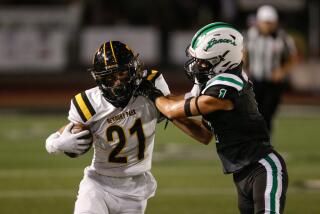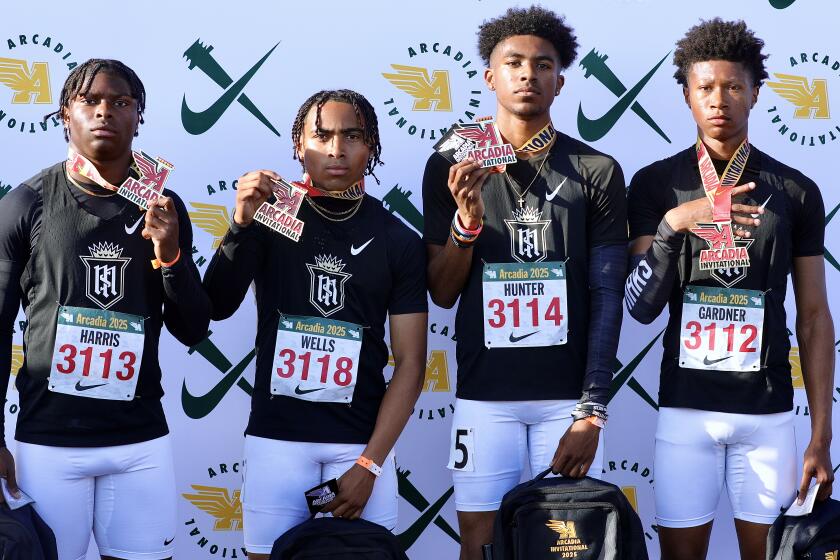An Update on the Belmont High Sentinel and Memories
- Share via
In lamenting the hard times that have fallen on high school newspapers, I noted that my old sheet, the Belmont Sentinel, is published only “irregularly” today.
Dentler Erdmann, Belmont’s dedicated journalism adviser, writes to explain why that is. The blame must fall largely on the chaos in continuity caused by Belmont’s year-round schedule.
When the semester starts, the journalism students must be taught the basics: how to incorporate the five Ws into a story--who, what, when, where, why. Also, they must be taught beats, photography, darkroom techniques, layout and numerous other skills, as well as how to write a sentence.
Eight weeks later some of those students go on vacation and new ones come along. They in turn must be taught the basics. Meanwhile, the original staff members are “abandoned,” while the new ones are being taught. Eight weeks later more students go on vacation and the others return. Eight weeks after that the semester ends and the entire process begins again.
One can understand why the Sentinel is published only irregularly, at best.
But that isn’t all, Erdmann says. English is not the primary language in many homes, so editing takes more time. Also, because of the staggered schedules, the print shop students, who print the Sentinel, are not always in school at the same time as the journalism staff.
Imagine what chaos would prevail at The Times if it had to begin every year with a brand-new staff, and every eight weeks thereafter suffered the loss of a good number of them. Then, when the reporters and writers and editors were on hand and ready to go, the printers would be out to lunch. I doubt that under those conditions The Times would be the complete newspaper it is today.
Meanwhile, Erdmann asks a favor. “I know,” he writes, “that you played basketball at Belmont. As a jock you must remember a great moment or two in Belmont sports. In the sports section we run a column called ‘Great Moments in Belmont Sports.” I would like for you to be a guest columnist and write one of your memories for ‘Great Moments in Belmont Sports. . . .’ ”
True, I played center on the Belmont Class B basketball team, and, in fact, I was season high-point man. There were so many great moments I can’t single any out.
But I think the single greatest moment was the day I went out for football. They gave us each a helmet and shoulder pads and lined us up in two lines facing each other. The ball was tossed to the first man in one line and he was to run toward the other line. Meanwhile, the first man in the other line was supposed to meet him head on and tackle him.
It was my fate to be a tackler. I didn’t know it at the time, but the man I drew to tackle was one Choppo Saavedra--a very tough hombre who was later to be all-city halfback.
He ran toward me with the ball. I ran out to meet him. I put my shoulder against his thigh, as instructed. Crunch! The impact was quite demoralizing. It rattled every bone in my body.
Choppo helped me up. I staggered straight for the dressing room. I turned in my helmet and my shoulder pads and never went out for football practice again.
I consider that one of the great moments in Belmont High School sports because it made a basketball player out of me.
Meanwhile, Gene Blake, for years my colleague at The Times, recalls that as editor of the Huntington Park High School Spartan Shield, he pulled numerous journalistic coups.
“Your characterization of the Belmont Sentinel as ‘not a great newspaper’ was probably too modest, and I will not similarly denigrate the Shield. It was great, and we also knew how to cope with deadlines.”
Blake recalls that for the 1936 Roosevelt-Landon election the Shield printed a special edition reporting a landslide Roosevelt victory. As soon as the returns were in, the Shield was delivered. (Blake notes that the Chicago Tribune would have been wise to use that method rather than prematurely distributing its run reporting a Dewey victory over Truman in 1948.)
He also recalls that when a popular student was badly injured in a train-auto collision, the Shield faced a deadline with no picture of her and little time to have one engraved if it had had one.
Blake went to the girl’s home and talked a photograph out of her grieving family (an embarrassing task, which, he says, was to become “hard-nosed routine” in his future years as a Times reporter). He then drove to the engraver’s downtown shop and the picture made the paper.
I once talked a woman out of her picture after her husband had just been arrested for shooting through a window into the bed in which she was entertaining a neighbor.
Now that was enterprise.
More to Read
Get our high school sports newsletter
Prep Rally is devoted to the SoCal high school sports experience, bringing you scores, stories and a behind-the-scenes look at what makes prep sports so popular.
You may occasionally receive promotional content from the Los Angeles Times.






